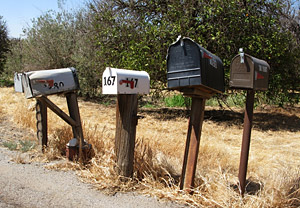 Welcome to 2015. Holiday cards and letters have been filed away, wrong sizes or colors have been exchanged, and now we must play catch up – pay bills, mind our New Year’s resolutions, and most likely, watch our waistlines, after some good holiday eating.
Welcome to 2015. Holiday cards and letters have been filed away, wrong sizes or colors have been exchanged, and now we must play catch up – pay bills, mind our New Year’s resolutions, and most likely, watch our waistlines, after some good holiday eating.
Each new year, I vow to be more on top of things, but somehow, the late year holiday frenzy always gets in the way. But I am happy to report that I hand wrote, stamped and mailed all of my year-end greetings this year, even though Social Correspondence suffered. After all, the U.S. Postal System needs us, right?
There is some good news on that front. The USPS shipped a record number of packages in December 2014. On Dec. 22, the busiest day of the year, the postal service shipped 28 million packages, the most ever, and 463 million pieces of mail. The month of December showed an increase of 18% in packages mailed over Dec. 2013.
More good news: the price of first class Forever stamps will remain the same this coming year. This might be a good time to stock up on your favorite designs. The cost of postcard and international mail most likely will increase slightly in the spring.
In other news, Postmaster General Patrick Donahue is retiring after 40 years with the postal service. In the past several years, Donahue has fought to gain more operational control over the USPS. The postal service receives no operational funding from the federal government, but rather, funding for postal operations comes from postage, products and services.
In his farewell address to the National Press Club, Donahue noted that retiree health benefits have become “an absurd mandate. Unlike practically any other organization, the Postal Service is required to prefund the retiree health benefits that we have promised to our employees. Unfortunately, Congress decided to make the Postal Service prepay a 40-year obligation in a ten-year period.” It should be noted that Congress does not require this of any other federal government agency.
Not everyone has been a fan of Donahue. In a budget balancing strategy, the postal service has been consolidating and scaling back operational and processing centers. A new round of lowered standards took effect on Jan. 5.
“It’s an outrage,” said American Postal Workers Union (APWU) President Mark Dimondstein. “Postal bureaucrats are virtually eliminating overnight delivery of first-class mail and periodicals, slowing down all mail delivery across the country, and jeopardizing the future of our great national treasure. At the same time, they’re causing major upheaval in the lives of workers.”
On Nov. 14, 2014, the APWU staged a protest at 150 locations as part of a National Day of Action to send a message to Stop Delaying America’s Mail! One of these locations is located in San Francisco’s Civic Center, in the Fox Plaza building. The protest was pretty low-key when I walked by. No shouting, no picketing, just a handful of workers passing out literature about the then proposed service cuts, which took place on Jan. 6, 2015. I stopped, but no one seemed particularly interested in talking with me.
Despite these challenges, the value of the postal service remains high. In a Gallup poll taken late in 2014, the U.S. Postal Service was ranked Good or Excellent by 72% of the respondents, the highest ranking of the 13 federal government agencies included in the poll.
In a further analysis done by Consumer Reports in December, comparing shipping of packages by the U.S.P.S. with FedEx and UPS, the U.S.P.S. overall ranked significantly higher than the other two services. The postal service came out on top in the areas of convenience, cost and reliability.
Still, the USPS continues with both ongoing and new struggles: inclement weather, downsizing of staff, consolidation of services, politics, and threats of privatization are all high on the list.
One of these threats is reduced and diminished mail service. As part of the January cutbacks, the delivery of first class mail will take longer. For those important documents still trusted to mail, be aware that delivery will take an extra day or two.
“The move, which now makes a first-class letter delivery take an average of 2.1 days instead of 1.8 days to reach its destination, comes as the Postal Service plans to eliminate 82 mail processing centers throughout the nation to save money,” reports the Santa Rosa (CA) Press Democrat.
Over the past year, some of these changes have already become apparent. Mail delivery in my neighborhood is less reliable and there are days when no mail is delivered at all, even in the height of the pre-holiday catalog season. Once reliable as a 10 or 11 a.m. delivery, mail now usually arrives after 5 p.m.
San Francisco is not alone. The Los Angeles Times reports the same phenomenon. According to the Postal Service, mail delivery after 5 p.m. is becoming an increasing problem in some parts of the country. The USPS cited staffing shortages as the main reason. The audit found that Washington, D.C., and parts of Atlanta and Miami had some of the highest rates of night deliveries
This new year will be a time of continuing change, but some things seem assured. Megan J. Brennan, currently Chief Operating Officer and Executive Vice President of the U.S.P.S., will assume the responsibilities of Postmaster General following the February 2015 retirement of Patrick Donahue, the first woman to hold the post in our country’s history. The USPS, unlike other federal government agencies, will be saddled with the debt of future pensions, creating deficits rather than a balanced budget. It will continue to adapt to new technologies and efficiencies, and to make the case for new revenue sources, including e-commerce. The struggle for power and control will continue.
Change is inevitable. Ways of communicating continue to evolve. But the U.S. Postal Service provides an important service on which most people rely, and public opinion supports this. The least we can do is empower them to change and adapt, to keep the good and give them the autonomy to find new solutions, while not hampering the operations with old baggage.
National Day of Action: Stop Delaying America’s Mail. APWU, 11/14/14
New US Postal Service standards to add delivery time to mail. Santa Rosa Press Democrat, 1/12/15
Postal Service Gets High Marks from the Public. The Baltimore Sun, 12/15/14
Postmaster General Addresses National Press Club. USPS, 1/16/15
Service Cuts Disrupt Workers’ Lives. APWU.org/news, 1/16/15
Residents are getting more nighttime visits from postal carriers. Los Angeles Times, 12/20/14
Shipping Comparison: FedEx vs. UPS vs. U.S. Postal Service. Consumer Reports, 12/17/14
USPS. United States Postal Service/Who We Are. Megan J. Brennan.





Dorothy Coakley
20 Jan 2015File this comment under the category “Misery Loves Company.”
In California, we get our mail after 5PM, having watched a postal worker take a break for fifteen minutes across the street from our house before delivering the mail. It’s legal, being his first break of the working day, but more than a trifle frustrating for us on the days when he doesn’t get around to making a delivery before heading back to the post office to restock for the next day.
In Washington, the situation is somewhat different. We are on a rural route where Frank the mailman knows everyone. (Frank also owns a large antique store in town so his gregarious personality is advantageous to his family. He’s the first to know if homeowner is deceased or a home is being sold. Estate sales bring profits to an early-bird who happens to have a brick-and-mortar store in the heart of our “Victorian Seaport.”
But Frank is retiring soon, his feet are killing him. So we will need to breaking a tenderfoot postal person. Routes take time to learn, mail boxes are hard to find and collection boxes are few and far between. Outgoing letters may arrive too late for a timely payment, despite our little metal flags waving bravely in the wind. Or in the snow, sleet and hail.
In both locations, other delivery services contract with the post office. Thus, a package that may have arrived days before languishes until USPS can make a delivery. This is the purpose of a tracking number, as far as I can tell. It lets you know that your package is somewhere in the area and may be delivered within the week. Or month.
Enough. I am glad to hear from Social Correspondence that our family is not alone. Although this prevents my mind from ruminating on issues of discrimination based upon age or redlining, it does provide some solace. We are not the only folks receiving intermittent mail service. File this response under “Misery Likes Company.” And subscribe to my new carrier pigeon service. We’re spot on, and work for crumbs. See you soon.
Richard Walsh
23 Jan 2015I can lament with Dorothy. Our mail will comes late in the day if Ricardo, our regular postman, is not on duty. Although my wife will write a check to pay a bill the day it arrives and then run to the Post Office to mail it, I can file a bill away and then pay it the day before it it due.
The worst part of a late mail delivery involves my 95 year old neighbor Millie. She lives for Saturday night broadcasts of the Lawrence Welk Show and for the delivery of her mail. She used to call me every hour on the hour to ask if I got my mail if it didn’t arrive by noon.. (Our mail usually arrives at noon.)
On the days she didn’t receive mail and I did she would ask me why she didn’t receive any. My only
answer was “ask the USPS.
I then talked to Millie’s care giver and suggested that when she went downstairs to get Millie’s mail that she always leave one or two pieces in the mailbox so that there would be something to give to Millie the next day when she wanted the mail. It has worked out splendidly. Millie always has mail and the caregiver only has to make one trip to the mailbox.